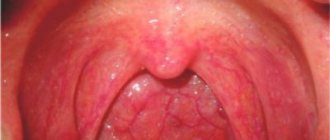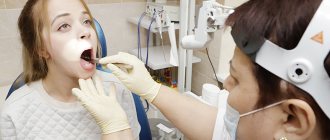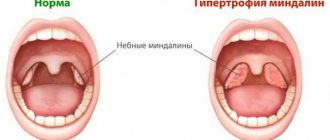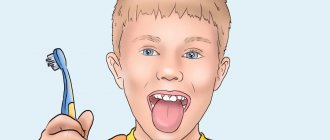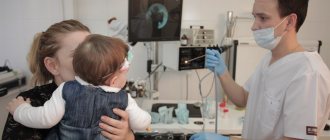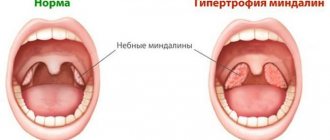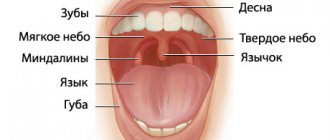Is it possible to wash tonsils with an irrigator?
In this article
- Is it possible to wash tonsils with an irrigator?
- Why rinse your tonsils?
- Is it possible to rinse tonsils with an irrigator?
- Flushing the tonsils with an irrigator
- How to rinse tonsils at home with an irrigator
- When is tonsil flushing contraindicated?
- Basic recommendations: how to properly rinse tonsils at home
First, a few words about tonsils and tonsillitis. The human throat provides ideal conditions for the proliferation of fungi, viruses and bacteria. Tonsils (tonsils) protect the respiratory system from pathogenic microorganisms. They have microscopic lacunae into which food debris, dead epithelial cells and microbes fall. Tonsils are an important part of the body's immune system; they protect the lungs from infectious diseases, but at the same time become vulnerable to disease. A viral or bacterial inflammatory process in the lacunae of the tonsils causes chronic tonsillitis - a long-term inflammatory process of the pharyngeal or palatine tonsils.
This pathology can cause a person many problems, causing bad breath, fatigue, pain and sore throat. In addition, tonsillitis can cause tonsillitis and other complications. Treatment of this disease is carried out by an otolaryngologist. He prescribes a course of antibiotics and drugs for washing the tonsils.
What are lacunae
The tonsils are covered on the outside with a mucous membrane with depressions called lacunae. They protect the body from pathogens and ensure filtration of everything that enters the mouth.
In the follicles that make up the tonsils, lymphocytes mature and are released onto the surface of the lacunae to destroy microbes. In a healthy person, the lacunae cleanse themselves.
Why rinse your tonsils?
Washing of the tonsils is carried out taking into account the characteristics of this organ. The tonsils are a collection of lymphoid tissue, inside of which there are small cavities and passages. They quickly fill with food debris, saliva and plaque from the teeth, which subsequently cause tonsillitis. Its manifestations can be minimized by washing the tonsils. You should contact an ENT specialist, who will prepare an antibacterial solution and carry out the procedure with a syringe or irrigator. Doing this yourself at home is dangerous, it can damage the tissue and cause complications.
The doctor may prescribe a course of physiotherapeutic procedures, the duration of which is 5-10 sessions - it all depends on the degree of the disease. When washing the tonsils, foreign substances and pus are removed from the lacunae. After several procedures, the process of self-cleaning of the tonsils begins. To avoid injury to the tonsils during tonsillitis, they can only be washed in the otolaryngologist’s office. Rinsing for the purpose of prevention is carried out at home using oral irrigators.
Contraindications
Removing blockages in the throat with an irrigator is not permitted in all cases. The procedure has some contraindications. It is prohibited to resort to it:
- with severe hypertension;
- with heart defects and vascular system;
- in the first and third trimesters of pregnancy;
- in the presence of oncological tumors;
- for pathologies of the retina;
- for glaucoma;
- at elevated temperatures;
- during acute infectious ENT diseases;
- in children up to three years of age.
Before using antiseptic drugs, you must make sure that they do not cause allergies. The procedure is performed very carefully so as not to injure the tonsils. Damage to the tonsils not only provokes pain and inflammation, but also leads to a general deterioration in health and exacerbation of chronic ailments against the background of decreased immunity.
Is it possible to rinse tonsils with an irrigator?
An oral irrigator is a device that, by supplying pulsating water, cleanses the teeth and gums of food debris. According to dentists, regular use of such devices helps prevent the development of caries, gingivitis, periodontitis and other dental diseases. The irrigator should be used as an additional hygiene product, along with a toothbrush and floss. You need to use it at least 2-3 times a week, and better yet, every evening after traditional teeth brushing.
Modern irrigators are multifunctional devices that are suitable for cleansing the oral cavity, massaging the gums and rinsing the tonsils. The device reservoir should be filled with plain water or a disinfectant solution, furatsilin and other products approved by a doctor and compatible with a specific device. Let's learn how to wash your tonsils at home using an irrigator.
Vacuum washing method
The vacuum method of rinsing using the Tonsillor apparatus is the most modern way to rinse the lacunae of the tonsils.
In simple terms, the nozzle of the Tonsillor device works on the principle of a vacuum cleaner. It is attached to the tonsil, the device creates negative pressure. The washing solution, passing through the lacunae of the tonsils, washes out their pathogenic contents, which, together with the waste solution, are sucked into a special cup of the nozzle. That is, the solution is used and passes through the tonsils only once, which confirms the sterility of the manipulation. Before washing, topical anesthesia of the tonsils is performed with lidocaine solution.
Despite the effectiveness of vacuum washing, this method is not without its drawbacks:
- it happens that the edges of the nozzle can injure the surface of the tonsil;
- The walls of the cup, where the washing solution that has passed through the tonsils is evacuated, is opaque, and the doctor cannot see whether the tonsils have been completely washed. As a result, the ENT doctor has to carry out additional procedures to certainly clear the lacunae.
A reasonable question arises: “Is washing the tonsils always associated with some risks?” No! There is another way to wash the tonsils - safe, effective and non-traumatic. This is the use of an improved Tonsillor attachment.
Flushing the tonsils with an irrigator
First you need to choose a suitable irrigator model. It can be portable or stationary, pulsed or microbubble. Portable models are not suitable for washing tonsils, as they have one significant drawback - the inability to smoothly switch the water supply mode. A sudden change in pressure and jet pressure can lead to tissue injury. Therefore, it is better to choose stationary models for washing the tonsils.
They are more functional and have several operating modes, including for cleaning gums and tonsils. In addition, stationary irrigators come with several nozzles, while portable ones are sold with one, or maximum two nozzles.
The minimum value of the cleaning jet pressure created by an irrigator suitable for washing tonsils should not be more than 150 kPa. Waterpik WP-108 E2 Ultra is ideal for this procedure - a stationary device that supplies pressure from 70 to 560 kPa. There is a lever on the handle for smooth switching of modes. You need to start the procedure with the weakest pressure, gradually increasing it. The device comes complete with 7 attachments. One of them is designed to clean gum pockets. It can also be used to wash the tonsils. Two standard attachments are also suitable for this.
Another suitable irrigator that can be used to wash tonsils is available under the brand name Aquapick AQ-300. It has several operating modes and 4 attachments included. The reservoir is quite large - 600 ml. It is enough for a complete cleaning for two or three family members. This device can be mounted on the bathroom wall using a bracket. It is not cheap, but it is one of the most functional. There is also a more budget option - B.Well WI-922. This device can be used to clear tonsils, but the minimum power it produces is 200 kPa. This irrigator is not suitable for children to wash their tonsils.
Our online store offers many stationary irrigators that can be used for washing tonsils. When purchasing, consider the following indicators: jet power, minimum pressure, number of operating modes, pulsation frequency and tank volume. Now we’ll find out how to rinse your tonsils with an irrigator at home.
How effective is the device?
High results from using the device are built into the principle of its operation. Mechanical removal of germs, plaque and food particles using a water jet will allow you to efficiently clean many places that toothbrushes, orthodontic brushes and other dental cleaning devices cannot reach. In addition, the pressure in most devices can be adjusted, which significantly improves the quality of the procedure.
How to rinse tonsils at home with an irrigator
It is better to rinse the tonsils on an empty stomach in the morning, since a stream of water entering the larynx can cause vomiting. Such reflexes cease to bother you after regular procedures. The duration of rinsing the tonsils is 2-3 minutes, but you can start from 30-40 seconds until slight discomfort appears in the throat. Washing is performed according to the following algorithm:
- stand in front of the mirror and take the irrigator handle;
- set the jet pressure to the minimum level;
- insert the tip of the device into your mouth and turn on the device;
- When changing the position of the device, turn it off each time.
Before washing, make sure the device is in working order. Fill the reservoir with a suitable solution.
Do not use decoctions and infusions. The smallest plant particles included in them can become clogged in the device’s filter and damage it.
After the procedure, you need to thoroughly clean the nozzle and put it in the case. When washing, do not swallow the solution, as it contains microbes washed out of the lacunae of the glands. Do not tilt your head back to prevent liquid from entering your respiratory tract.
After the procedure, you may feel dry mouth and sore throat. This is a normal reaction of the body to the solution used and the pulsation of the liquid. Subsequently, the larynx will get used to the effects of pulsating water. However, if you experience a sore throat and blood in your saliva, stop using the irrigator and consult a doctor. At home, only preventive cleaning of the tonsils is possible. For tonsillitis, you need to undergo the procedure in the ENT office.
Rinsing with a modified Tonsillor nozzle
This method of washing will not be offered to you in any of the clinics in Moscow, except for the ENT Clinic of Doctor Zaitsev! An improved, modified attachment for the Tonsillor apparatus was developed by the founder of the ENT clinic, Vladimir Mikhailovich Zaitsev, together with his colleagues. The operating principle of the new nozzle is absolutely the same as that of the classic nozzle. The difference is in its structure:
- the improved “Tonsillor” nozzle creates greater negative pressure, due to which rinsing the tonsils is much more effective and of better quality;
- the edges of the nozzle in contact with the tonsils do not cause damage or microtrauma;
- The cup of the nozzle into which the washing solution with the purulent contents of the lacunae is sucked in is transparent, and the doctor immediately sees at what point the procedure can be stopped. Thus, the patient does not undergo unnecessary manipulations.
- The size of the nozzle allows washing even for children.
It is necessary to rinse the tonsils only with the participation of an otolaryngologist. We do not recommend self-medication!
In order to forget about the symptoms of chronic tonsillitis for a long time, it is necessary to undergo a full comprehensive course of treatment of chronic inflammation, including, in addition to rinsing, drug therapy and physiotherapeutic procedures. This is the only way to preserve the tonsils and achieve stable remission!
When is tonsil flushing contraindicated?
The procedure is not recommended for people with arterial hypertension - there is a risk of a sharp increase in blood pressure. Also among the contraindications:
- acute infectious diseases of the gums, teeth and throat;
- increased body temperature;
- retinal pathologies and glaucoma;
- severe heart failure;
- 1st and 3rd trimesters of pregnancy;
- allergy to solutions used for rinsing.
Do not use faulty appliances. An irrigator can damage your gums and tonsils if the jet pressure is too strong. If the device does not work well, replace it.
Is there any point in using it?
You can also brush your teeth with a toothbrush. But only an irrigator can remove plaque and food particles from all hard-to-reach places, including various orthodontic structures, as much as possible.
Using a water jet, it literally washes them away from all hard-to-reach areas, thereby reducing the likelihood of caries. At the same time, it additionally massages the gums, improving their blood supply. Massage prevents the formation of periodontitis, and in combination with special medical solutions, it not only inhibits the development of its chronic form, but also treats it.
In most devices, the jet pressure can be adjusted, which significantly improves the quality of the procedure performed.
Basic recommendations: how to properly rinse tonsils at home
Experts advise adhering to the following rules when washing your tonsils:
- choose only high-quality irrigators with several operating modes and the ability to regulate pressure;
- wash your tonsils to prevent tonsillitis if it has already been diagnosed once;
- carry out the procedure in courses of 5-10 procedures with intervals of several months;
- during the period of preventive treatment, avoid spicy and hard foods (crackers, chips, etc.), which can burn or scratch the larynx;
- After rinsing, gargle with an antiseptic solution.
Recommendations after procedures
Rinsing the lacunae of the tonsils is a physical effect on the inflamed tissue, so after cleansing, discomfort and mild pain are possible.
You cannot eat immediately after the procedure, the first meal should not be earlier than 30 minutes later. It is necessary to regularly gargle with miramistin, furatsilin solution, infusion of chamomile, oak bark.
Washing the tonsils is not a very pleasant procedure, but it is done quickly. Its effectiveness has been proven by many years of use for the relief of chronic tonsillitis.
Are there any complications?
Despite the fact that washing the lacunar cavities is one of the most effective and safe techniques, sometimes patients experience adverse reactions. List of common complications:
- Tissue damage. Irritation and microtrauma of the epithelium cause painful sensations when swallowing. This happens when the procedure is performed by an inexperienced doctor or due to accidental movements of the patient.
- Allergic reactions. After washing out the purulent plugs, the cavities are treated with an antiseptic. If you have an allergy, there may be a local reaction: redness and swelling of the tonsils, or a general reaction, manifested by skin rashes and nasal congestion. If you are allergic to an antiseptic, replace the product.
- Spread of infection. During the leaching process, the contents of the lacunar cavities can get onto nearby mucous membranes and cause inflammation of the nasopharynx, pharynx or respiratory tract.
- Exacerbation of chronic diseases. The mechanism of the pathology is not fully understood, but it is assumed that an exacerbation is provoked by a local decrease in immune defense, when leukocytes are washed out of the lacunae along with pus. A person’s temperature rises, sometimes up to 40°C, weakness appears, and the lymph nodes become enlarged. In case of exacerbation, the course of therapeutic lavage is interrupted until the patient’s condition improves, and then the procedures are continued.
Most often, when washing the lacunar folds, microdamages occur in children and suspicious patients who, despite anesthesia, have difficulty sitting still. Other complications are relatively rare.
Schemes for preparing antiseptic solutions
Self-production of Furacilin, medicinal decoctions, saline solution and a number of other disinfecting liquids is allowed. Cooking methods are listed in the table below.
| Solution | Way | Proportions |
| Saline | Sea or table salt is combined with warm water. | 1 teaspoon of substance per 200 ml of liquid |
| Furacilin | The drug tablet dissolves in boiled water; the solution is infused for up to half an hour. | 2 pills per glass of water |
| Chlorophylliptate | The medicine is mixed with water. | 1 part drug to 5 parts liquid |
| From propolis | The alcohol (aqueous) tincture is diluted with water. | Alcohol: 1 tsp. medical product for half a glass of liquid. Water: 1:3 |
| From medicinal herbs | Medicinal infusions (oak bark, sage, chamomile, calendula) are poured with boiling water, infused for 30 minutes, and filtered. | 1 tablespoon per 200 ml of boiling water. |
When using solutions for the treatment procedure, you must remember the main rule: if you have an individual intolerance to the components of the product (this is often manifested by allergic reactions), the use of disinfectant liquids is prohibited.
Diagnostics
THE INSTITUTE OF ALLERGOLOGY AND CLINICAL IMMUNOLOGY has a fundamental base that allows it to carry out the full range of diagnostic and therapeutic measures for any form of allergy that meets the level of international standards. Many of the diagnostic and treatment methods were developed by the staff of our Institute.
Diagnostic measures are based on anamnesis, clinical picture and laboratory diagnostics.
- Bacteriological examination of mucus from the tonsils and posterior pharyngeal wall for aerobic and facultative anaerobic microorganisms.
- Determination of the sensitivity of microorganisms to antibiotics and other drugs.
- Detailed general (clinical) blood test, clinical urine test.
- Determination of the concentration of C-reactive protein in blood serum.
- Determination of antistreptolysin-O in blood serum.



